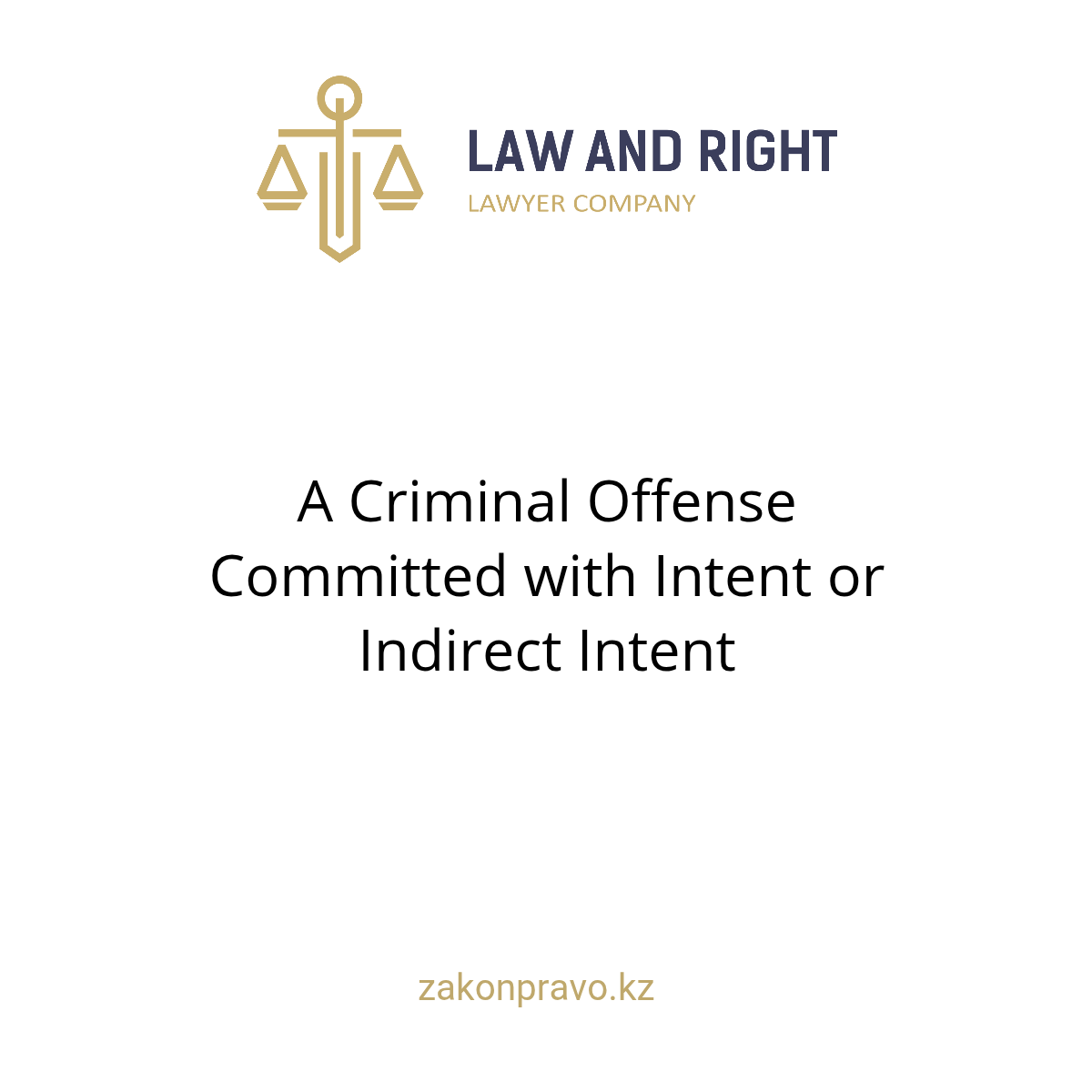A Criminal Offense Committed with Intent or Indirect Intent
Article 20 of the Criminal Code of the Republic of Kazakhstan (hereinafter — CC RK) reveals the concept of intent as a form of guilt, which is a mandatory element of the subjective side of a crime. It is divided into direct and indirect intent. Below is a detailed explanation, an extensive legal commentary with examples, and references to related provisions of other codes and normative resolutions of the Supreme Court of the Republic of Kazakhstan.
📌 1. Legal Essence of Intent
Intent is the conscious mental attitude of a person toward a socially dangerous act and its consequences. It is a fundamental condition for criminal liability, reflecting guilt in the subjective sense (see Article 19 of the CC RK).
📘 2. Direct Intent (Part 2 of Article 20 of the CC RK)
A crime is committed with direct intent if:
- the person was aware of the social danger of their actions;
- foresaw the possibility or inevitability of consequences;
- and desired these consequences to occur.
📌 Example from practice:A person deliberately inflicts knife wounds to another’s vital organs — this constitutes intentional infliction of death (direct intent).
📖 Related norms:
- [Article 99 CC RK] — Murder;
- [Article 106 CC RK] — Intentional infliction of grievous bodily harm;
- [Article 45 CC RK] — Sentencing in the case of multiple crimes (where the intent covers several criminal acts).
📘 3. Indirect Intent (Part 3 of Article 20 of the CC RK)
A crime is committed with indirect intent if:
- the person was aware of the social danger;
- foresaw the possibility of consequences;
- did not desire, but consciously allowed their occurrence or treated it indifferently.
📌 Example from practice:A driver under the influence drives on a busy road, understanding the possibility of an accident, but continues driving. If a pedestrian dies, this may be classified as a crime committed with indirect intent (depending on the circumstances).
📖 Related norms:
- [Article 345 CC RK] — Violation of traffic rules resulting in death;
- [Article 367 Civil Code of the RK] — Liability for harm caused by a source of increased danger.
⚖️ 4. Distinguishing from Negligence (Article 21 CC RK)
It is essential to distinguish intent from negligence:
- In negligence, the person neither desires nor allows the consequences;
- In intent, the person either desires or consciously allows (indirectly).
📖 See also:
- [Article 21 CC RK] — Crime committed by negligence;
- Normative Resolution of the Supreme Court of the RK No. 1 dated July 11, 2003: "On the practice of applying legislation on liability for crimes committed with various forms of guilt."
⚖️ 5. Significance for Crime Qualification
The form of guilt determines:
- the possibility of holding someone criminally liable;
- the legal qualification of the crime;
- the severity of punishment (see [Article 53 CC RK] — mitigating circumstances).
📌 Examples:
- Direct intent to kill — Article 99 CC RK;
- Death caused by indirect intent — may be qualified under Article 104 CC RK (intentional infliction of moderate bodily harm resulting in death by negligence).
📄 6. Related Normative Resolutions of the Supreme Court of the RK:
- Normative Resolution No. 6 dated July 11, 2003Covers the application of Article 68 CC RK on exemption from criminal liability due to reconciliation with the victim. Discusses application in cases involving intent.
- Normative Resolution No. 3 dated March 31, 2017Amends prior resolutions regarding criminal and procedural law, clarifying the application of norms concerning intent.
- Normative Resolution No. 10 dated December 22, 2022Introduces updates aimed at refining judicial practice, including questions related to intentional guilt.
- Normative Resolution No. 1 dated April 21, 2011Concerns sentencing principles and emphasizes the importance of intent in determining punishment.
- Normative Resolution No. 2 dated December 25, 2020Focuses on crime qualification in offenses against life and health, stressing the need to prove the internal mental state regarding the consequences of one’s actions.
🔍 7. Proving Intent
Intent cannot be established solely on assumptions. There must be:
- Objective data: behavior, circumstances, tools used;
- Expert opinions (e.g., psychological or psychiatric assessments);
- Witness testimony, correspondence, recordings, etc.
📖 See also:
- [Article 113 Criminal Procedure Code of the RK] — Procedure of proving;
- [Article 125 CPC RK] — Assessment of evidence based on the court’s inner conviction.
🧾 Conclusion
Article 20 of the CC RK plays a pivotal role in differentiating between forms of guilt and in determining criminal liability. The distinction between direct and indirect intent significantly affects the legal qualification of an act, as well as the type and degree of punishment. Judicial practice and normative resolutions of the Supreme Court provide essential clarification for the correct application of this norm in real cases.
Attention!
Law and Law Law Law draws your attention to the fact that this document is basic and does not always meet the requirements of a particular situation. Our lawyers are ready to assist you in legal advice, drawing up any legal document suitable for your situation.
For more information, please contact a Lawyer / Attorney by phone: +7 (708) 971-78-58; +7 (700) 978 5755, +7 (700) 978 5085.
Attorney at Law Almaty Lawyer Legal Services Legal Advice Civil Criminal Administrative Cases Disputes Protection Arbitration Law Firm Kazakhstan Law Office Court Cases


